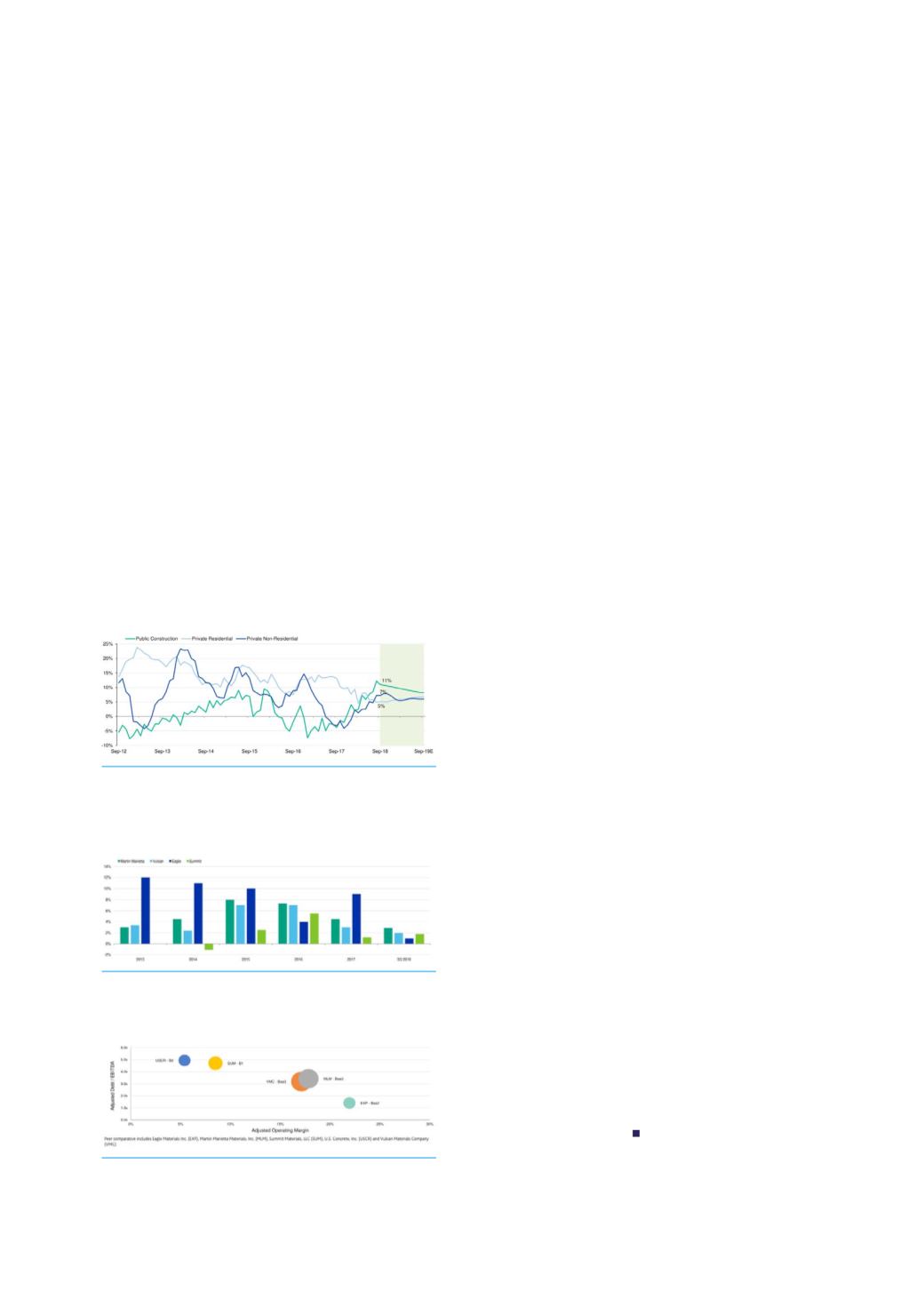
6
World Cement
North America 2019
construction should grow by 4% in 2019, with
the predominance of activity being generated by
industrial and institutional construction, according
to the American Institute of Architects’ consensus
construction forecast. This forecast shows slowing
commercial building construction and is lower
than expectations of 4.7% growth in 2018. Again,
labour constraints, as well as the high cost of
materials and land, support Moody’s stable view for
private non‑residential construction over the next
12 − 18 months.
Public infrastructure
Public infrastructure spending remains robust,
particularly at state level. Construction spending in
the public sector has grown since late 2017, reaching
11% year-on-year growth as of September 2018
(Figure 1). Continued, albeit somewhat slower,
growth of 8% is expected in 2019, as states continue
to pass new long-term legislation supporting highway
construction. For example, in November 2018,
California voters rejected a repeal of Senate Bill One,
also known as the Road Repair and Accountability Act
of 2017. This is a gas tax increase passed to help pay
for highway infrastructure throughout the state.
At the federal level, the Fixing America’s Surface
Transportation Act will provide funding until 2020
for public infrastructure, close to 75% of which is
allocated to the Federal Highway Administration.
Moody’s remains cautious on public infrastructure
spending growth beyond 2020, particularly at the
federal level, as other agenda items will likely take
priority during an election year.
Overview
Price increases have largely moderated, but still remain
positive. The ability of building material companies to
increase prices across all products has diminished
in 2018, and is another indicator of tempering in the
sector. Aggregates pricing growth is currently in the low
single‑digits (Figure 2). On the positive side, pricing and
volume growth is helping to offset labour constraints
and higher material costs on margins. In addition, the
rated building material companies continue to report
strong backlogs, despite weaker earnings in 2017 and
2018 due to the weather.
Product mix continues to shift towards
aggregates. Several building materials
companies rated by Moody’s have either
increased their percentage of revenues coming
from aggregates, or recently made major
acquisitions in the aggregates space. These
include Vulcan Materials Co. (Baa3 stable),
Martin Marietta Materials Inc. (Baa3 negative), and
US Concrete Inc. (B2 stable). Restrictive permitting
processes in most metropolitan areas and high
transportation costs make the aggregates industry
very regional in nature and limit competition.
Accordingly, aggregates producers benefit from
better pricing power through cycles, compared to
sellers of cement and ready-mixed concrete.
Solid credit metrics and strong liquidity have helped
to mitigate volatility in earnings. The Moody’s-rated
US building material companies have good credit
profiles, with leverage that has generally trended
down over the last decade. Internal liquidity is strong,
with minimal near‑term maturities, high levels of cash,
and line availability. Furthermore, the building material
companies have strong cash flow generation, with a
demonstrated ability to generate positive cash flows
during economic downturns.
Conclusion
Moody’s could revise its outlook back to positive
if the industry’s organic operating income growth
increases above 7%. This is coupled with continued
solid momentum in public, private residential, and
private non-residential construction, as well as stable
federal highway spending. However, the outlook
could change to negative, if the industry’s organic
operating income contracts by 3% or more, if there is
a reversal in end market momentum, and/or if there is
a reversal of broader economic indicators pointing to
recessionary conditions.
About the author
Griselda Bisono is a Vice President
–
Senior Analyst in
Moody’s Corporate Finance Group.
Figure 1. Total construction put in place
(year-on-year change). Public construction
spending growth is expected to outpace private
construction spending growth.
Figure 2. Aggregates year-on-year change.
Pricing growth has largely moderated, but
remains positive.
Figure 3. Moody’s adjusted debt/EBITDA and
operating margins. Solid credit profiles support
current credit ratings.








